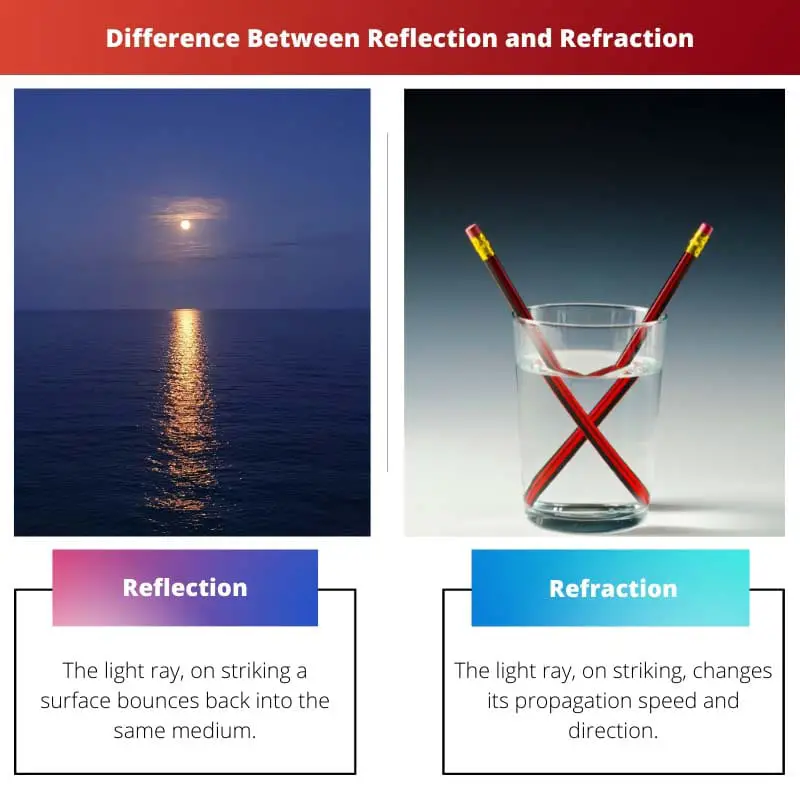Ever wondered how we can perceive and see different things? Reflection and refraction are phenomena that depend on the properties of light, which is why we can see different things.
Key Takeaways
- Reflection is the process by which light waves bounce off a surface, changing direction without passing through the material, resulting in phenomena like mirror images.
- Refraction is the bending of light waves as they pass through different media with varying densities, causing effects like the distortion of objects seen through water or glass.
- The primary distinction between reflection and refraction lies in how light interacts with a surface or medium, with reflection involving a change in direction and refraction causing the bending of light waves.
Reflection vs. Refraction
Reflection is the process by which light bounces off a surface at an angle equal to the angle at which it strikes the surface. Light can either be absorbed by the material or reflected when it strikes a surface. Refraction is the process by which light bends as it passes through a boundary between two different media.

Reflection is when the light that strikes a surface or a medium bounces back into the same medium instead of going through the medium. This is what forms images, and these images are commonly known as reflections.
Refraction is when the propagation speed of the light rays changes on striking a medium, and they change their direction along with it. But they do not form a perfect image of the object; instead, they form a distorted one.
Comparison Table
| Parameters of Comparison | Reflection | Refraction |
|---|---|---|
| Meaning | The light ray, on striking a surface, bounces back into the same medium | The light ray, on striking, changes its propagation speed and direction |
| Surface | It mostly happens on a shiny surface like a mirror | Mostly happens on transparent surfaces like a lens |
| Angle of incidence | It is equal to the angle of reflection | It is not equal to the angle of refraction |
| Image formation | A perfect or almost perfect representation of the actual object | The image formed is distorted, and it depends on the angle of incidence |
| Propagation speed | No change is recorded | The propagation speed changes. |
What is Reflection?
Reflection is the phenomenon of light when the rays strike a medium, but it is bounced back into the same medium instead of entering the second medium.
This phenomenon is commonly observed in shining and smooth surfaces. These surfaces reflect most incident light rays forming a perfect or an almost perfect replica or image of the object.
The number of reflected rays does not only depend on the smoothness of the surface but also on the physical properties of the object that is to be reflected.
Reflection works on the laws of reflection. This law states that the angle of incidence is always equal to the angle of reflection.
This law also states the incident ray, the reflected ray, and the normal should always lie in the same plane.
The human eyes can perceive the color of various objects due to reflection and the reflective properties of each object. The objects absorb some and reflect some of the light rays of a specific wavelength.
The reflected rays are what determines the color of an object.

What is Refraction?
Refraction is when the light rays incident on a surface or medium, instead of bouncing back, enter the medium but also experience a change in their propagation speed and direction.
This phenomenon is commonly observed in transparent surfaces like glass or lenses. Instead of reflecting the light waves, the surfaces enter the medium to form a distorted image of the object.
The distortion of the image depends on the angle of incidence and the angle of refraction.
Similar to reflection, refraction also works based on laws known as laws of refraction. This law states that the common ratio between the angle of incidence and the angle of refraction is known as the refractive index.
This measures the characteristic of refraction for the medium and surface. Also, the angle of incidence, the angle of refraction, and the normal should lie on the same plane.
This phenomenon helps the human eyes perceive different objects around us. The light rays reflected from different objects are refracted by the lens of our eyes, which then converges at the retina to form the image.
For a corrected lens, the light rays undergo two refractions before it converges at the retina.

Main Differences Between Reflection and Refraction
- Reflection and refraction treat the light rays differently on striking the surface. During reflection, the light bounces back into the same medium. But during refraction, the light enters the medium, but it experiences a change in the propagation speed and direction.
- Although they are both properties of light rays, they are seen on different surfaces. A shining surface, such as a mirror, is used for reflection. But for refraction, a transparent surface such as a lens is used.
- Since the two depend on two different laws, the properties of the angle of reflection and refraction are also different. The angle of reflection is always equal to the angle of incidence of the light ray on striking the surface. Still, the angle of refraction is not equal to the angle of incidence during the phenomenon of refraction because it is seen that the light ray changes direction.
- The propagation speed during reflection does not change as there is no change in the medium. But for refraction, since the direction and the medium change, this changes the refractive index and the propagation speed of the light rays.
- The medium of propagation of light rays does not change during reflection because the light rays only bounce back to form a replica of the image in the medium. But during refraction, there is a change in the medium because the light rays enter the second medium on incidence.

- https://www.osapublishing.org/abstract.cfm?uri=josa-58-4-551
- https://iopscience.iop.org/article/10.1088/0953-8984/3/32/017/meta

This is a very interesting and informative article that explains reflection and refraction in a clear and concise manner. I appreciate the detailed explanation of the laws of reflection and refraction.
Absolutely, the comparison table is very helpful for understanding the key differences between reflection and refraction.
I agree, it’s great to have a comprehensive understanding of these phenomena.
The article does a great job of outlining the key differences between reflection and refraction and provides a solid understanding of both concepts.
I completely agree, it’s an excellent summary of these optical phenomena.